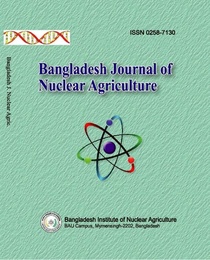PROFITABILITY ANALYSIS OF BINADHAN-20 PRODUCTION IN SOME SELECTED AREAS OF BANGLADESH
Abstract
This study was conducted to analyze the profitability of Binadhan-20 producing farmers in Mymensingh, Jamalpur and Rangpur districts of Bangladesh. This study was based on primary data which were collected from 150 Binadhan-20 producing farmers. In the sampled areas data were collected through pre-designed interview schedule from February-March, 2022 for achieving the purpose. In the study, costs and return analysis were done on both cash cost and full cost basis for estimating profitability. The cultivation of Binadhan-20 was profitable from the viewpoint of the farmers. The study found that Binadhan-20 production is profitable. The average net return per hectare was Tk. 29964. The net return was highest in Rangpur (Tk. 31735/ha) followed by Mymensingh (Tk. 30142/ha) and Jamalpur (Tk. 28015/ha), respectively. Benefit cost ratio was 1.41 and 2.02 on full cost and cash cost basis implying that the Binadhan-20 cultivation at farm level was profitable. Cobb-Douglas production function was chosen to determine the factor affecting gross return of Binadhan-20 production. All of the factors namely, human labour cost, power tiller cost, seed cost, fertilizer cost, irrigation cost, wedding cost and insecticides cost were statistically significant and positive. The regression coefficients for farming experience and agricultural training under all areas had negative but significant relationship at 5% and 10% level, respectively. The regression coefficient of age was positive and significant at 5% level. Under all areas, the regression coefficient of education and farm size was positive but not significant. The farmers in the study areas encountered some constraints to Binadhan-20 production. The first ranked constraint was unavailability of seeds in all areas (92%). Other constraints were lack of training (65%), lack of technical know-how (40%), natural calamities (36%), lack of capital (26%) and low education level of farmers (14%). The economic return of Binadhan-20 production encouraging to the farmer’s for more production.
References
Alam, M.J., McKenzie, A.M., Begum, I.A., Buysse, J., Wailes, E.J. and Van Huylenbroeck, G. 2016. Asymmetry price transmission in the deregulated rice markets in Bangladesh: Asymmetric Error Correction model. Agribusiness. 32(4): 498–511.
Alam, M.S. and Islam, M.A. 2013. Long-Term Assessment of Rice Production Scenario in Bangladesh: A Macro Dynamics. Bangladesh Journal of Agricultural Research, 38(2): 257–269.
Bapari, M.Y. and Joy, M.A.K. 2016. Estimation of Rice Production Function in Rajbari District, Bangladesh: an Econometric Analysis. Asian Journal of Humanity, Art and Literature. 3(1): 99-112.
Barmon, B.K. and Chaudhury, M. 2012. “Impact of Price and Price Variability on Acreage Allocation in Rice and Wheat Production in Bangladesh,” Agric., vol. 10, no. 1, pp. 23–30.
BBS (Bangladesh Bureau of Statistics). 2020. The Yearbook of Agricultural Statistics, Statistics and Informatics Division (SID), Ministry of Planning, Government of the People’s Republic of Bangladesh, Dhaka, Bangladesh.
BBS (Bangladesh Bureau of Statistics). 2015. Statistical Pocketbook Bangladesh 2015. Statistics and Informatics Division, Ministry of Planning, Government of the People’s Republic of Bangladesh.
Chowdhury, N.T. 2013. “Marginal product of irrigation expenses in Bangladesh,” Water Resour. Econ., vol. 4, pp. 38–51.
Mainuddin, M. and Kirby, M. 2015. National food security of Bangladesh to 2050. Food Security. 7:633–646.
Mottaleb, K.A. and Mishra, A.K. 2016. Rice consumption and grain-type preference by household: a Bangladesh case. Journal of Agricultural and Applied Economics. 48:298–319.
Rahman, F., Shammi, S.A., Parvin, M.T., Akter, N., Khan, M.S., and Haque, S. 2016. Contribution of Rural Women to Rice Production Activities in Two Different Areas of Bangladesh. Progressive Agriculture, 27(2): 180–188.
Sarker, M.A.R., Alam, K. and Gow, J. 2012. Exploring the relationship between climate change and rice yield in Bangladesh: An analysis of time series data. Agricultural. System. 112:11–16.
Sarker, M.N.I. 2017. “An Introduction to Agricultural Anthropology: Pathway to Sustainable Agriculture,” J. Sociol. Anthropol., vol. 1, no. 1, pp. 47–52.
Shozib, H.B., Siddiquee, M.A., Rahman, N.M.F., Mamun, M.A.A., Sarkar, M.A.R., Rabbi, S.M.H.A., Salam, M.U. and Kabir, M.S. 2020. Grain quality research of rice for ensuring nutritional food security. Bangladesh Rice Journal, 24(2): 105-120.
Timsina, J., Wolf, J., Guilpart, N., van Bussel, L.G.J., Grassini, P. and van Wart, J. 2018. Can Bangladesh produce enough cereals to meet future demand? Agric. Sys. 163:36-44.
-
Download



